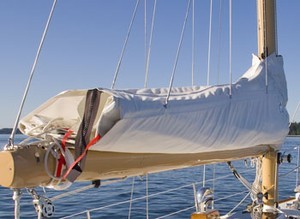12 Design tips for the best sail-cover in the world
by Sail-World Cruising on 16 Mar 2009

Cradle sail cover - working like a dream... Photo by Neil Rabinowitz SW
Having a great sail-cover for your boat makes life at sea so much more comfortable. A sail-cover that offers too much windage, is hard to handle or has to be replaced often through wear, can take some of the fun out of a day's - or a month's - sailing. Here are 12 design tips to remember when having your next sail-cover made:
1. Make sure the sail cover has a low profile. Some sail covers have such a high profile that they have almost the area of a storm trysail. The more windage, the more a boat will tend to sail at anchor. It takes some smarts on the part of the sail maker to space the battens so that the profile of the cover is lowered considerably, and a flat top is achieved. Having a flat-top has other advantages: it is easier to zip up because there is less tension on the Zipper as it is not trying to pull the Lazy Jacks together. It is also easier to reach the Zipper.
2) Having a flat top brings its own challenges, of course, which have to be countered. When it rains, water gathers in the folds of the sail. Therefore the sail cover needs a removable vinyl storm gusset that wraps around the sail and directs the rain that enters to the bottom of the cover and out the drains built into the cover.
3) Ensure that Spectra Lazy Jacks are used with no blocks. To save on weight and to reduce chafe, use sailmaker’s closed thimbles. The Jacks attach to the sail cover via eye splices that the pultruded battens pass through inside the cover.
4) Attaching the Lazy Jacks to the battens takes the load off the cover and transfers it to the battens to reduce stress and chafe on the cover.
5) Make sure the battens are an appropriate size to resist sagging and come in convenient lengths with custom aluminum splice joints.
6) It is a good idea for the sail cover not to be attached to the sail so it can be rolled and stowed on top of the boom in a few minutes. From a hundred feet away, the rolled up cover it is almost invisible.
7) Make sure the Lazy Jacks are adjusted at the mast on a horn cleat, which also acts as a spot to loop the Lazy Jacks out of the way when the cover is rolled.
8) The sail should be loose footed and not attached to the cover so that you can adjust the sail for optimum sail shape.
9) Having the cover custom fitted will ensure that it is much better fitting than a generic cover can achieve. Using an ill fitting or too large cover can lead to more of the Storm Trysail effect.
10) Use a big zipper. Don't use a big zipper, use a HUGE zipper. Make sure it has excellent UV properties. It needs to be salt and sun resistant, so it can't be too tough.
11) A sail cover system like this eliminates the need for reef ties.
12) Use a good fabric. Don't use a good fabric, use a GREAT fabric, something that will give you a ten year guarantee. You'll never be sorry. An offshore cover built with lesser quality fabrics will look the same at first but can fade within two years and worse, lose its strength.
Sail-World Cruising would like to thank Tim Knight of UK-Halsey Sailmakers for his contribution of information for this article. Naturally, UK-Halsey put all of these good features above into their sail-covers. For more information about sail covers or any other sail making information, go to the UK-Halsey Sailmakers' site by clicking HERE
If you want to link to this article then please use this URL: www.sail-world.com/54882